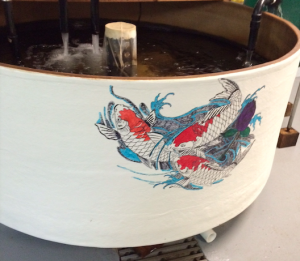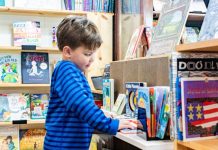
As I step into the John M. Smith Aquaculture Center, I am immediately struck by the focused group of people, all absorbed in activity. Dr. Amanda Gunn waves me down from where she is standing, knee-deep in an aeration tank, scrub brush in hand. She promptly begins our tour. She calls the workspace simply the Fish Lab and starts by telling me the story of how it came to be.

Dr. Gunn says that the series of events leading to the Fish Lab’s emergence was serendipitous. The entire project was born when a student approached her, wanting to learn more about rehabilitating fish into local habitats. Dr. Gunn says that the student wondered if this was something they could try. She enthusiastically responded yes, directly in line with her passion for working with students.
Hailing from California, Dr. Gunn’s original area of expertise is in infectious diseases. After graduating with a PhD in Molecular Biology and Genetics from City of Hope National Medical Center, she began working as the Integrated Sciences Laboratory Director at The Claremont Colleges. It was here, she says, where her interest in helping students seize opportunities and pursue their interests began. She realized there were major disparities in science and education. Although the opportunities for students in the sciences were vast, many students, particularly in community colleges, were either unaware of the options, or did not believe they could achieve these goals.
“As I was working with these students,” she says, “I kept thinking to myself, ‘Wow. I wish I had known about some of these opportunities when I was in school.’ I had never heard of so many of these things.”
She began seeking out ways to increase student awareness about available educational opportunities. This focus inspired her to move to Seattle for one year, and look for work at a community college. She found her calling at Grays Harbor College (GHC).

At GHC, Dr. Gunn is as committed to teaching and research as she is to helping her students explore their interests, develop and pursue projects, and find answers to questions they have outside the classroom. What began as a student’s simple interest in salmon rehabilitation turned into a complete renovation project of the Fish Lab. Originally believing they would only need a tool shed to begin the project, Dr. Gunn was given permission to use a small space in the Center.
“But then we got attached to the building,” she says.
Alongside numerous student volunteers, Dr. Gunn and her crew gutted the space and began building and eventually expanding their tool shed. All the building materials involved in renovating the Fish Lab and creating the necessary equipment were almost all recycled materials. Nearly 1,000 volunteer hours went into creating what exists today.
And, building the Fish Lab was a new learning experience for not only the students but also Dr. Gunn who acquired new skills. “One student taught me how to install plumbing,” Dr. Gunn comments. At the onset of the project, Dr. Gunn was just as new to fisheries as her curious students were. Something new was exactly what she had been hoping to find for her research. She didn’t only want her interests to be the focus of her research pursuits. She wanted her research to provide opportunities to the students at GHC.

“I think it’s great for students to see that I don’t always have the answers,” she says. She talks about how scientists are always looking for answers to questions and trying to solve problems, but that students are often disconnected from this process. Through the Fish Lab, students see the hard work and elbow grease that comes with scientific investigation. It provides a hands-on experience that certainly would be missed if learning were limited to a classroom environment.
Learning opportunities through the Fish Lab are not only limited to science students either. “We try to keep our doors open to everybody and create a safe and inclusive learning environment where students, faculty, and community members can be a part of something. It is about more than just the fish – it is about making it fun to learn about and preserve our ecosystem,” she says.
Everyone from youth in the community, to local organizations, to art students have taken part in working on the Fish Lab. Students from other disciplines have begun volunteer work and found new interests, and been inspired to pursue traditional science degrees. Even Dr. Gunn has been able to take her infectious disease research in a new direction. She found herself developing vaccines for fish.

Determined, resourceful, ambitious, and a passionate team member, Dr. Gunn emphasizes that the work involved in the Fish Lab is not hers alone. She credits the students and the greater community for the accomplishments.
“Grays Harbor has a strong and caring community with the ability to achieve seemingly impossible goals. For my students, I hope the Fish Lab can act as a mirror, to show them just how strong they are and that they can do anything. Just looking at what they have accomplished so far makes me incredibly proud to say that I am on their team,” Dr. Gunn says.
Future plans for the Fish Lab include collaborating with the Lake Aberdeen Hatchery, a field trip to Satsop Springs, moving coho salmon from egg trays to indoor troughs, painting murals on the outside of the building, and as always, recruiting volunteers. To follow future activities and developments in the Fish Lab, please see their newsletter.












































